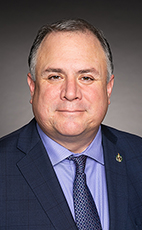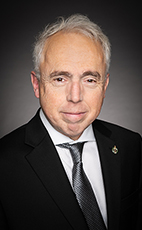44th Parl. 1st Sess.
May 18, 2023 10:00AM
- May/18/23 12:16:50 p.m.
- Watch
Madam Speaker, I will be splitting my time with the hon. member for Peterborough—Kawartha.
After eight years of the Prime Minister, everything feels broken. Life costs more. Work does not pay, and housing costs have doubled. The Prime Minister divides to control the people. Worst of all, crime and chaos, and drugs and disorder rage in our streets. Nowhere is it worse than the opioid overdose crisis that has expanded so dramatically in the last several years.
This is an important debate we are having today. The opioid addiction crisis is real, and it is costing Canadian lives. The unimaginable pain that those who are suffering from addictions are going through, as well as that of their families, their friends and their loved ones, cannot be understated.
I know that many of us here have probably gone to too many funerals, and I know I have, of those who were suffering from addiction because of this crisis. Many times when we talk about those who are addicted or people who are struggling with addiction, we think about the people who we might see in the downtown or who might be homeless. It is true, some of them are. However, very often they are also the people we know, people we may not have expected, people who might be family members, co-workers, friends or neighbours, people who we would not expect to be in that situation but are in this crisis and are suffering from addiction.
We know there is no simple solution. The issue here is very complex and there are many factors that affect it. What we can see is that the Liberal government approach is not working. The Liberal plan is not helping those who are struggling to get past their addiction and fully recover. In fact, those Liberal policies have actually made the situation worse.
I want to read from the text of the motion today. It says:
...given that,
(i) Canada is in the midst of an opioid crisis that has killed over 35,000 people since 2016,
(ii) since 2017, the federal government has spent over $800 million on its failed Canadian Drugs and Substances Strategy, including over $100 million in funding for hard-drug supply projects across Canada, and plans to spend an additional $74 million to “scale up” these projects over the next five years,
(iii) since tax-funded drug supply was ramped up in 2020, opioid deaths have only gone up, according to the Public Health Agency of Canada,
(iv) in 2020, slightly less than 7,000 people died of opioid overdoses, while only 3,000 died of overdoses in 2016, according to the Library of Parliament,
(v) in British Columbia alone, yearly drug overdose deaths have increased by 330% between 2015 and 2022,
(vi) recently, a Global News reporter in East Vancouver was able to buy 26 hits for $30 in just 30 minutes of a dangerous and highly addictive opioid that is distributed in tax-funded drug supply programs and flooding our streets with cheap opioids,
the House call on the government to immediately reverse its deadly policies and redirect all funds from taxpayer-funded, hard drug programs to addiction, treatment and recovery programs.
What would Conservatives do?
Conservatives believe that addiction is a health condition and that it should be treated as such. A Conservative government would have a recovery-oriented system of care that helps people on their journey. This means prevention, intervention, treatment and recovery. Conservatives believe that we have to meet people where they are at, but we need to stop leaving them there. We should be helping them get their lives and their families back, and help them fully recover.
It is not just that the Liberal program is a failed experiment that has been tried and which has failed in other cities in other parts of the world. The scary part is that their program is adding more drugs to the streets, which is making the drug supply cheaper, so there are now more drugs on the streets. It has become more affordable for those trying to purchase them.
There is a B.C.-based physician who says that, before safe supply, before the government's program, 8 milligrams of hydromorphone tablets sold for $10 in Vancouver's downtown east side. The doctor says it now costs between 50¢ and a dollar.
Dr. Vincent Lam, the medical director of Coderix Addiction Therapy, provided insight into the situation in downtown Toronto, so we are going from from Vancouver to Toronto. According to his patients, 8 milligrams of the same drug tablets that used to go for $20 on the street now sell for between two dollars and five dollars, and sometimes as little as one dollar.
A doctor in Ottawa said that 24 milligrams of hydromorphone, which they believe came from the city's safe supply facilities, sells for two dollars on the street. Before safe supply, they were selling for $20 to $30. A representative from the Nanaimo Area Network of Drug Users said that the system is broken. They estimated that up to 80% of safe supply drugs in Nanaimo, B.C., are currently being diverted. The system definitely is broken. It is not working.
What is happening is that those who are struggling with these addictions are selling the drugs they are receiving from the government. They are selling them because they need stronger drugs. These ones do not work any more. They are selling them at such a low cost that even our young Canadians, children and youth, are able to buy them for one or two dollars a hit. We are creating a cycle where more and more Canadians are getting more addicted rather than breaking that addiction.
This crisis has left Canadians struggling right across the country, and it does not see background or religion. I have talked to many parents in South Asian communities who have seen their children go through these addictions and go through the struggle.
I visited a gurdwara in Surrey where the head of the gurdwara said that they have sent home international students, and we are talking hundreds across the country. They have had to send home their bodies. Many of them have stresses. There are pressures that they face, having come to Canada. They are young, and it is different, so there is loneliness. There are pressures on them, financial stress. Many of them have become addicted to drugs, and many of them have overdosed. This itself has become a pandemic and a serious crisis in the community.
All of this, addictions, the use of drugs and the supply of drugs, have also led to more gang activity as well, which has led to more of our young people dying. They are being killed in gang activity. Conservatives' common-sense plan would end taxpayer dollars for drugs and put people in addiction, treatment and recovery programs. Conservatives will bring our loved ones home, drug-free.
1169 words
- Hear!
- Rabble!
- add
- star_border
- share
- May/18/23 12:27:02 p.m.
- Watch
Madam Speaker, it seems there is conflation of a lot of issues, when I hear the member opposite speak. I was looking at a study from U of T about safe consumption sites, and it says that there was a city-wide overdose mortality reduction of 42% between the time when we started, before we had safe consumption sites, and now. Not only that, but in neighbourhoods that are 500 metres around a safe consumption site, the overdose mortality rate decreased by 67%. In the Canadian Medical Association Journal, there was also a study from London, Ontario, that showed that mortality decreased with safe supply.
While I am not denying that there is, in fact, an opioid crisis and that there are fentanyl deaths, does the member opposite not agree that there is medical evidence that safe supply is actually saving lives?
142 words
- Hear!
- Rabble!
- add
- star_border
- share
- May/18/23 12:27:57 p.m.
- Watch
Madam Speaker, the unfortunate part of this debate is that the government has chosen to pick certain facts to go on and it ignores other facts. The fact of the matter is that deaths have been going up. Opioid overdoses have gone up. Drugs supplied by the government to those struggling with addiction are now available on the streets, and the cost of drugs has been reduced, so they can be purchased by our young people. That is the reality. That is what is happening across our country, and that is what is making this crisis worse.
That is why we are saying that we need to stop the taxpayer-funded drugs and help these Canadians suffering from addictions with treatment.
121 words
- Hear!
- Rabble!
- add
- star_border
- share
- May/18/23 12:28:52 p.m.
- Watch
Madam Speaker, I can hear the Conservatives' concern. As my colleague from Longueuil—Saint-Hubert said earlier, we are addressing an extremely sensitive and important issue, but they are not providing effective and vetted solutions. The Conservatives' approach is very similar to that of the Americans. It has been said before. We have been saying it since this morning. The results in the United States are not very encouraging. Quite the opposite. The number of opioid-related deaths has dramatically increased since 2015. The Conservatives' suggestion is to focus more on rehabilitation centres, centres to help addicts get off drugs. Those already exist and they are working, but the crisis keeps getting worse.
Does my colleague not think that it is time to focus on new ways of dealing with drug addiction, as has proven to be successful elsewhere in the world, unlike the American approach, which has shown to be ineffective?
154 words
- Hear!
- Rabble!
- add
- star_border
- share
- May/18/23 12:29:59 p.m.
- Watch
Madam Speaker, it is true that we do have recovery programs in Canada, but the problem is that we need more of them; they need to be more available. I talk to many parents whose children are suffering from these addictions about recovery programs. There are long wait times, and some of these programs are extremely expensive, so they are not able to get their children into these programs, nor their family members, their friends or whoever they may be.
Our plan is to stop giving taxpayer-funded hard drugs to those with addictions, and it is to put all that money the government has been providing to that into addiction programs to help those struggling with addictions through treatment. That is what would help Canadians right across the country.
130 words
- Hear!
- Rabble!
- add
- star_border
- share
- May/18/23 12:30:54 p.m.
- Watch
Madam Speaker, in his speech, the member said that Conservatives want to meet people where they are at. However, repeatedly we have said that people need options. Safe supply, treatment and abstinence programs offer different approaches and services, and they give people in those situations choices. In order to save lives, it is about the choice they need. Supporters of safe supply do not think that safe supply is a panacea, by any means, to solve all addiction problems, but in this place of privilege in which we sit it is our obligation to provide choices.
How can the member possibly say that he and his party are working to meet people where they are at, when they do not provide all the choices that we know consistently, with facts and statistics, do just that?
135 words
- Hear!
- Rabble!
- add
- star_border
- share
- May/18/23 12:31:50 p.m.
- Watch
Madam Speaker, this is about facts and statistics, and the very sad fact is that opioid deaths have been going up, especially after the government started this program of so-called safe supply. Just in B.C. alone, there has been a 330% increase in overdose deaths. Those are the facts. That is why we need to change the system. It is not working. The government's plan does not work. We need a better plan. A Conservative plan would focus on treatment and compassionate care.
86 words
- Hear!
- Rabble!
- add
- star_border
- share
- May/18/23 12:32:27 p.m.
- Watch
Madam Speaker, after eight years of the Prime Minister, everything feels broken. Life costs more, work does not pay and housing costs have doubled. The Prime Minister divides to control the people. Worst of all, crime and chaos, drugs and disorder rage in our streets. Nowhere is this worse than the opioid overdose crisis, which has expanded so dramatically in the last several years.
This is a really tough subject, and it is very tough when we are challenging what many people thought they knew. Addiction is a ruthless, cold-blooded thief. It is a vile disease that destroys families and lives. It is a disease that preys on its innocent host in unimaginable ways. Addiction will make the victim say and do anything to anyone in order to eliminate the pain.
That is where we need to focus our efforts, and that is what our opposition motion today does. Instead of putting a band-aid on the gushing wound, Conservatives are saying, let us treat the trauma and let us destroy the predator and save the host. Conservatives are calling on the Liberals to redirect their taxpayer money from safe supply to treatment and recovery and bring our loved ones home. Conservatives are asking to invest in understanding why and to fund recovery. Conservatives want to give people suffering with addiction back their life, their family and their body.
I believe safe supply is one of the most powerful marketing campaigns ever released. Let us be honest. If a loved one had a life-threatening disease, people would buy or agree to anything that would keep them alive. They would not ask questions. They would just hear that it would keep them alive and sign the dotted line. The idea of safe supply has sold a whole culture of people a falsehood, a hope that they will save their loved ones, but the reality is that safe supply just keeps them where they are. It allows addiction to continue to prey on its innocent host. Honestly, it is a hell of a business model. Why not keep the customer coming back for more?
There is a distinct difference between OAT and safe supply, and it is critical that everyone watching listens to the difference, because once they do, I believe they will understand that Conservatives are the only party offering a compassionate solution to the biggest crisis our country has ever suffered.
Evidence-based medication refers to opioid agonist therapy, or OAT. It includes drugs such as Suboxone, Sublocade and methadone. This is different from Canada's safe supply, which includes drugs like hydromorphone. Hydromorphone is equivalent to heroin.
OAT is a recovery-oriented therapy that addresses the torturous and sometimes deadly withdrawal symptoms that opioid addicts experience when they stop using their drugs. These symptoms are a major barrier to recovery if left untreated. I highly recommend everyone watch Dopesick. It is one of the best public education tools out there to understand this.
I have many friends who have lived a full life or who live a full life in recovery thanks to OAT. With OAT, those in recovery are given long-lasting, milder opioids that stave off withdrawal without providing any high or euphoria, helping patients live free of narcotic impairment. The administration of OAT is tightly controlled. Patients generally must come to a clinic every day for supervised consumption. Take-home use is strictly monitored.
In contrast to OAT, safe supply drugs are intended to mimic the highs of illicit substance use, not manage withdrawal. Safer supply does not move patients toward a drug-free life. It is, in theory, intended to prevent overdoses and death until one is ready to begin their recovery journey.
Many people who are not on board with our solutions will say that it is the deadly supply of fentanyl on the streets that is killing people, and they are absolutely correct, but guess how those dealing with addiction are getting that deadly, toxic dose of fentanyl? They are selling their government-funded safe supply. Why are they selling their government-funded safe supply? It is because they need a stronger high. Never before have we had such powerful drugs. The physiological dependence on these drugs cannot be overstated.
It turns out that hydromorphone is too weak to get fentanyl users high, and, for this reason, many safer supply recipients simply sell (“divert”) their government-provided hydromorphone on the street, at rock-bottom prices, to purchase more street fentanyl. Safer supply doesn’t dissuade illicit fentanyl consumption—it subsidizes it.
That is a direct quote from Adam Zivo from the National Post.
The type of studies they (safer supply advocates) are doing are the weakest. The bottom line is that they're not comparing—this is the unethical part—they're not comparing hydromorphone programs to the standard of care, which is methadone.... That would be more ethical.
That was said by Dr. Lori Regenstreif.
...it's very common for my patients to tell me that they know people who sold most, if not all, of their prescriptions for PSADs [public supply of addictive drugs]. Unfortunately, that means that the hydromorphone is going somewhere else.
That was said by Dr. Vincent Lam.
How do we prevent overdoses? We must invest in prevention, in naloxone and in programs that treat the “why” in addiction. Until people who are addicted understand why they are using, they will never be free. Until people have the support they need, they are stuck. Conservatives are asking this House and demanding that the Liberals redirect funding from safe supply to treatment and recovery.
Canada is in the midst of an opioid crisis that has killed over 35,000 people since 2016, and that number does not account for the collateral damage that addiction leaves for families. How many kids are traumatized because their parent is stuck in the grip of addiction or has lost a parent, a sister, a mother, a daughter, a brother, an aunt to addiction?
Since 2017, the federal government has spent over $800 million on its failed Canadian drugs and substances strategy, including over $100 million in funding for hard-drug supply projects across Canada, and plans to spend an additional $74 million to scale up these projects over the next five years. Since tax-funded drug supply was ramped up in 2020, opioid deaths have only gone up, according to the Public Health Agency of Canada. In 2021, more than 8,000 people died of opioid overdoses, while less than 3,000 died of overdoses in 2016. It is not working.
I just cannot explain a more horrible disease than addiction. There are parents at home right now who are waiting for a phone call because they had a bright, amazing child who maybe got hurt and was prescribed opioids or maybe had trauma and used drugs to escape the pain. They are waiting for a phone call saying their child has died. Imagine if the Liberals committed to spending $800 million on treatment and recovery instead of drugs that are funding drug dealers. I know this is hard. So many people got sold an idea and it was wrong. Again we see an example of the government spending money in all the wrong places.
The path out of addiction takes full commitment, and access to treatment and recovery must be available instantly. Seconds matter. We need housing away from the life that will put them back where they were, and we need to invest in prevention. Mentally healthy, resilient kids turn into mentally healthy, resilient adults. Treating the problem with the problem is not a solution. Safe supply is killing our children. The data is in, and overdoses are up 300%.
Today the Conservatives are asking the House to call on the government to immediately reverse its deadly policies and redirect all funds from taxpayer-funded hard-drug programs to addiction treatment and recovery programs. Let us be leaders and invest in recovery and treatment, and let us bring everyone's children home safely.
1352 words
- Hear!
- Rabble!
- add
- star_border
- share
- May/18/23 12:42:06 p.m.
- Watch
Madam Speaker, I will agree with the member opposite that there is much more beyond prescribed harm reduction to resolve the issues we are facing with the opioid crisis. Where I disagree is that the British Columbia coroners office specifically stated, “There is no indication that prescribed safe supply is contributing to illicit drug deaths.” It is British Columbia's coroner who said that.
How does the member opposite respond to that fact from what I would think is a respected source?
84 words
- Hear!
- Rabble!
- add
- star_border
- share
- May/18/23 12:42:44 p.m.
- Watch
Madam Speaker, again, the statistics speak for themselves. Overdoses are up 300%; that is just the reality of it.
I really want to touch on a critical point, and that is the fear that has been instilled in experts who are on the ground. I am going to read something from somebody who has worked for three decades in treatment and recovery. This person, for the record, is not a Conservative.
This person says, “I have to agree with the leader 100%... But for people speaking out against it, you become vilified, like we don't care about people. Hydromorphone doesn't even come close to the strength of fentanyl. I had one young fellow tell me, if someone dies from an overdose, people are trying to find out who the dealer is so they can purchase from them because of the strength. We are just throwing—
149 words
- Hear!
- Rabble!
- add
- star_border
- share
- May/18/23 12:43:35 p.m.
- Watch
I have to give the same time for the question and the answer.
Questions and comments, the hon. member for Beauport—Limoilou.
23 words
- Hear!
- Rabble!
- add
- star_border
- share
- May/18/23 12:43:39 p.m.
- Watch
Madam Speaker, I will seize on what my colleague just read. I believe it is important to have a holistic and comprehensive view of the situation in order to support people with addictions and help them find a way out, while ensuring that we undercut the black market and resellers.
I would like my colleague's opinion about the importance of investing in mental health and support for people with addictions and making investments to deal with the black market.
80 words
- Hear!
- Rabble!
- add
- star_border
- share
- May/18/23 12:44:21 p.m.
- Watch
Madam Speaker, that is such a great question, because it is exactly what we are saying. That is why we really hope we get the Bloc's support on this.
Imagine we redirected the funds that are going into funding drug dealers, because that is ultimately what safe supply is doing, and put it into mental health supports. There is a Mental Health Commission report from 2016. How much has been done on that? Nothing.
We have people with mental disorders living on the streets. Why? Because we have nothing from the Liberal government to help people with mental disorders and addictions. That is the reality. That is what we are asking for today.
114 words
- Hear!
- Rabble!
- add
- star_border
- share
- May/18/23 12:45:02 p.m.
- Watch
Madam Speaker, what the Conservative motion today would do is have everybody who uses drugs go to the streets. They would get unregulated, toxic drugs, which are flooding our streets.
It is not safe supply that is killing people. Safe supply is still in its infancy. Very few people are on it or could even access it.
Again, I want to go back to the OAT and the safe supply conversation. I really appreciated the member talking about that. OAT is critical and absolutely essential, but people who feel it is not strong enough are going to the street to top up. This is where we need to have safe supply, and work with OAT in cohesion.
Also, this is supported by the Police Chiefs of Canada. This is supported by Gwen Boniface, the former OPP police chief who has a bill in the Senate. This is supported by Vancouver police, who called out the Leader of the Conservative Party this morning in The Globe and Mail for misinformation.
Why are the Conservatives railing against the police, when they are the tough-on-crime party?
185 words
- Hear!
- Rabble!
- add
- star_border
- share
- May/18/23 12:46:05 p.m.
- Watch
Madam Speaker, I hope my colleague votes in favour of this today, because I know how much he cares about this.
Dr. Koivu, a doctor who was a massive advocate for safe supply, said that several patients voluntarily left their homes to move into tents located in a parking lot near a pharmacy that dispensed safe supply drugs. They wanted to be close to the action, to buy hydromorphone early in the morning when it was the cheapest on the black market for consumption and profitable resale. She is now convinced that safe supply exacerbates homeless.
If the House, the NDP and the Liberals care about homelessness, mental health and helping people, then they should vote in support of this motion.
121 words
- Hear!
- Rabble!
- add
- star_border
- share
- May/18/23 12:46:49 p.m.
- Watch
Madam Speaker, I will be splitting my time with the member for Winnipeg North.
I am grateful for this opportunity to speak today to discuss the ongoing toxic drug overdose crisis. While I do that, my thoughts are on the many people we have lost in London, Ontario, a lot of friends and family, to this overdose crisis, which continues to exact a heartbreaking toll on individuals, families and communities across the country.
As the representative for London West and the former municipal representative for the downtown core of London, I have had the opportunity to see first-hand the hard work and dedication that our frontline workers have put into saving lives and improving outcomes for Londoners experiencing addiction.
I want to take this opportunity to thank them and to thank the Middlesex-London Health Unit, the Regional HIV/AIDS, the London InterCommunity Health Centre and anyone else who has dedicated their time, our volunteers, to helping the most vulnerable people experiencing this disease that has put them through unimaginable situations.
This dual pandemic has impacted people from all walks of life, ages, education levels and party lines, including many of us in the House today. We can no longer say that it is a stranger or that it is happening over there, because it is happening in all our communities. We are talking about our children, our friends, our parents and our neighbours, which is why I cannot understate the importance of a compassionate, collaborative and integrated response to reducing substance harms and saving lives.
Since 2016, Dr. Andrea Sereda of the London InterCommunity Health Centre has been running a safer supply program that has saved countless lives. Thank God, she is doing this work as an experienced doctor. We are not taking opinions from op-eds or online news; we are actually looking at studies that have been conducted by experts in the field. However, the program received federal funding in March of 2020.
Between April 1, 2020 and March 31, 2021, overdoses in the area dropped from 59% to 23%, 44% of the clients had not committed a crime to pay for drugs since beginning the program and one third of clients stopped using IV drugs. This is only one small piece of the empirical evidence that a safer supply actually works.
Prevention, harm reduction, treatment and enforcement make up the four internationally-recognized pillars of drug policy. Sadly, the Conservative Party does not understand the importance of the harm reduction pillar, preferring instead to ignore hard evidence and research, and is taking us back to the failed ideology of the Harper-era drug policy, which was costly, ineffective and deadly.
We are hearing from experts themselves, especially in communities like London, Ontario, where we know that a safer supply is working, that we need to continue to explore all avenues to address this ongoing crisis.
Our government, on the other hand, is committed to responding to this crisis from a whole-of-system and evidence-based approach. To date, we have launched many actions and investments to address the overdose crisis, including increased naloxone access, increased options for opioid agonist treatment, supervised consumption sites, which we have in the community of London, Ontario, and safer supply programs, whose importance, sadly, continues to be negated by the opposition.
An integral part of our response is ensuring that we have the best research evidence to inform our health policies and practices, and ultimately lead to better health and safety outcomes for all Canadians. This is where the incredible work of the Canadian Institutes of Health Research, or CIHR, comes in.
Over the last five years, CIHR has invested more than $179 million in research related to substance use, including $75 million in research related to opioid use alone. With its help, our government is supporting priority research initiatives that are now helping policy-makers and health care providers identify effective solutions for addressing the overdose crisis.
I want to begin by highlighting a pan-Canadian research network that is focused on substance use, the Canadian Research Initiative in Substance Misuse, or CRISM, which connects researchers, service providers, decision-makers and people with lived experience of substance use from across Canada.
CRISM's overall objective is to translate evidence-based interventions for substance use into clinical practice, community-based prevention, harm reduction and health system changes. The network is now recognized as a critical network that responds to the policy and evidence needs of decision-makers.
With ongoing support from the federal government, CRISM is able to conduct clinical trials, develop national treatment guidelines, promote the effective implementation of evidence-based interventions into clinical and community settings, and provide key evidence for decision-makers, like ourselves.
In June 2022, our government announced that it would be renewing CRISM with an investment of $17 million over six years to build and expand on the success of the initiative’s first phase, including by increasing the number of regional nodes from four to five to enhance geographic coverage.
This renewed investment also includes $5 million over four years for CRISM to undertake a national controlled trial in the management of methamphetamine-use disorder. The expertise and guidance that CRISM provides is integral to improving the quality of care and quality of life for people in Canada who use substances.
Outside of this investment, in 2019, CIHR also invested $1.5 million to support the evaluation of interventions implemented across Canada in response to the opioid crisis. This included evaluation of overdose prevention sites, rapid access addiction medicine models of care and naloxone programs, just to name a few. It also included research to evaluate non-pharmacological interventions for pain management.
Research to address the toxic drug and overdose crisis became even more critical during COVID-19, which exacerbated the existing crisis to a devastating extent. As part of the pandemic response, our government committed to, through CIHR, launching a funding opportunity in 2019 to support the evaluation research into harm-reduction approaches and to address the opioid crisis in the context of COVID-19. We know that this has grown since COVID-19.
This funding opportunity provided $2.2 million to support five research projects to assess the implementation and impact of safer supply interventions and supervised consumption sites, thereby addressing pressing evidence needs of decision-makers and knowledge-users in the area of harm reduction.
Additionally, CIHR mobilized CRISM to rapidly develop six national guidance documents to support people who used drugs, decision-makers and care providers during COVID-19, for example, guidance on telemedicine support for addiction services. We are also prioritizing bold policy changes to help people who use substances on their journey.
Last year, our government announced a time-limited exemption from the Controlled Drugs and Substances Act to the province of British Columbia, allowing for the personal possession of small amounts of certain illegal substances. Through this exemption, we will be able to reduce the stigma, the fear and the shame that keeps people who use drugs silent about their use, or using alone, and help more people access life-saving support and treatment.
Notably, the exemption included requirements related to comprehensive monitoring and evaluation. In addition to efforts led by B.C., our government is supporting an arms-length evaluation of this exemption.
This five-year evaluation project, led by CRISM, will study the impacts of the exemption and help us understand the full impacts of decriminalization in B.C., including the health and socio-economic impacts. This scientific evidence will be critical to ongoing decision-making as it relates to the overdose crisis.
We are also supporting critical research through CIHR’s investigator-led programs, which supports world-class research submitted by scientists at universities and research institutions across the country.
In addition to supporting the translation of research into improved programs and policies related to substance-use treatment and prevention, we will also be supporting research focused on improving health human resources related to substance use.
For example, CIHR is currently funding a project led by Dr. Kathleen Leslie and Dr. Mary Bartram at Athabasca University that will provide better information about policy options and stakeholder priorities to help create a pan-Canadian mental health and substance-use workforce strategy. This strategy will support the development of a high-quality, sustainable, diverse and culturally competent workforce that will have the capacity to provide equitable access to mental health and substance-use services for all Canadians.
1415 words
- Hear!
- Rabble!
- add
- star_border
- share
- May/18/23 12:57:00 p.m.
- Watch
Madam Speaker, I am disappointed to hear partisan rhetoric coming from the member across the way.
The member for Cumberland—Colchester, who gave his remarks this morning, actually has experience specializing in chronic pain. He is a doctor. He talked about the people struggling with addictions as real people who need community, who need connectedness and who need hope.
I did not hear the member talk about wraparound services. I just wonder whether she sees value and importance, like the Conservatives do, in housing, counselling and even psychotherapy for people who are struggling with addictions. Can the member let us know whether that is of importance to her, and not just say that Conservatives do not care about people? We do.
122 words
- Hear!
- Rabble!
- add
- star_border
- share
- May/18/23 12:58:01 p.m.
- Watch
Madam Speaker, I would like to start by saying that, as I stand in the House to speak on behalf of people in London, Ontario who have lost their lives to this crisis, it is tone-deaf for the member opposite to say that we are speaking in rhetoric. It is the Conservatives who are making this a very partisan issue, when we have people from across the country. This is an issue that has no party lines, and the Conservatives have chosen to make it a partisan issue.
Unfortunately for this member, we are sent here to make sure we can speak on behalf of those who can no longer speak on their own behalf. It is important that we continue to talk about how safe supply has saved lives in London, Ontario.
134 words
- Hear!
- Rabble!
- add
- star_border
- share
- May/18/23 12:58:54 p.m.
- Watch
Madam Speaker, my colleague mentioned a million programs that help people, including with the problem we are discussing this morning, but there is one she did not talk about.
I am currently touring Quebec on the topic of the housing crisis. We are hearing that in this post-pandemic period, and it is connected to addictions, there is more homelessness than there was before and in places where we did not see any before. I am talking about places such as Shawinigan, Rimouski or small towns north of Joliette, where there are absolutely no services.
People always think that homelessness is limited to big cities like Montreal, Vancouver and Toronto, but the fact is that we are now seeing visible homelessness, not just hidden, in places like small rural municipalities. There is a severe shortage of funding for homelessness in this country.
My colleague does not seem to realize that we are in a severe housing crisis, which is very much related to the topic we are discussing this morning. Does my colleague not think it is high time for the government to address the root cause of this problem and launch a Marshall-type plan to deal with the housing crisis and homelessness?
204 words
- Hear!
- Rabble!
- add
- star_border
- share
- May/18/23 1:00:00 p.m.
- Watch
Madam Speaker, I am sorry to have annoyed my colleague opposite for mentioning all the work we are doing to ensure that we deal with this very important crisis affecting the entire country, a crisis that is affecting everyone with children and families.
That said, there are always opportunities to do more and to ensure that we do so in areas that have not yet received funding.
If earlier I mentioned the list of things we have done, it was not to annoy my colleagues, it was to reiterate that we are ready to continue making these investments so that Canadians find themselves in a healthier situation.
107 words
- Hear!
- Rabble!
- add
- star_border
- share
- menumenu
- notificationsnotifications
- home
- mailmail
- searchsearch













